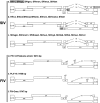Going wild: lessons from naturally occurring T-lymphotropic lentiviruses
- PMID: 17041142
- PMCID: PMC1592692
- DOI: 10.1128/CMR.00009-06
Going wild: lessons from naturally occurring T-lymphotropic lentiviruses
Abstract
Over 40 nonhuman primate (NHP) species harbor species-specific simian immunodeficiency viruses (SIVs). Similarly, more than 20 species of nondomestic felids and African hyenids demonstrate seroreactivity against feline immunodeficiency virus (FIV) antigens. While it has been challenging to study the biological implications of nonfatal infections in natural populations, epidemiologic and clinical studies performed thus far have only rarely detected increased morbidity or impaired fecundity/survival of naturally infected SIV- or FIV-seropositive versus -seronegative animals. Cross-species transmissions of these agents are rare in nature but have been used to develop experimental systems to evaluate mechanisms of pathogenicity and to develop animal models of HIV/AIDS. Given that felids and primates are substantially evolutionarily removed yet demonstrate the same pattern of apparently nonpathogenic lentiviral infections, comparison of the biological behaviors of these viruses can yield important implications for host-lentiviral adaptation which are relevant to human HIV/AIDS infection. This review therefore evaluates similarities in epidemiology, lentiviral genotyping, pathogenicity, host immune responses, and cross-species transmission of FIVs and factors associated with the establishment of lentiviral infections in new species. This comparison of consistent patterns in lentivirus biology will expose new directions for scientific inquiry for understanding the basis for virulence versus avirulence.
Figures




References
-
- Adams, D. 2005. The restaurant at the end of the universe, p. 266. In The ultimate hitchhiker's guide. Gramercy Books, New York, N.Y.
-
- Aghokeng, A. F., W. Liu, F. Bibollet-Ruche, S. Loul, E. Mpoudi-Ngole, C. Laurent, J. M. Mwenda, D. K. Langat, G. K. Chege, H. M. McClure, E. Delaporte, G. M. Shaw, B. H. Hahn, and M. Peeters. 2006. Widely varying SIV prevalence rates in naturally infected primate species from Cameroon. Virology 345:174-189. - PubMed
-
- Allan, J. S., J. Strauss, and D. W. Buck. 1990. Enhancement of SIV infection with soluble receptor molecules. Science 247:1084-1088. - PubMed
-
- Allen, T. M., D. H. O'Connor, P. Jing, J. L. Dzuris, B. R. Mothe, T. U. Vogel, E. Dunphy, M. E. Liebl, C. Emerson, N. Wilson, K. J. Kunstman, X. Wang, D. B. Allison, A. L. Hughes, R. C. Desrosiers, J. D. Altman, S. M. Wolinsky, A. Sette, and D. I. Watkins. 2000. Tat-specific cytotoxic T lymphocytes select for SIV escape variants during resolution of primary viraemia. Nature 407:386-390. - PubMed
Publication types
MeSH terms
Grants and funding
LinkOut - more resources
Full Text Sources

